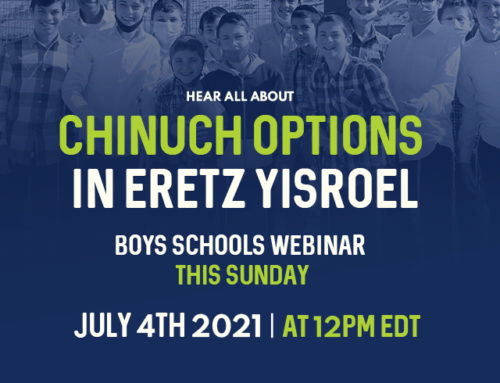By Rabbi Yair Hoffman for 5tjt.com
Israel is opening up for seminaries and Yeshivos once again – because of the vaccines. And the following information is crucial to know.
What do all these terms mean? How come we never learned about all of this when we were in Yeshiva?
To address this issue, the following article about Shmittah has been prepared.
Opportunity for Dveikus
Each of the Mitzvos of the Torah are each unique, not only in respect to the details of their specific halachos, but also in terms of their unique manner in which they foster, Dveikus Bashem, developing a close relationship with HaKadosh Boruch Hu. The relationship with one’s parents is instructive here. A son who has lost his father can fondly recall when his father helped him with homework, as well as when he may have gotten up in the middle of the night to go out and purchase a specific medicine. Reviewing both of these recollections serves to strength the bonds and connection that the son had with his father. Each of the 613 Mitzvos offer us a different way in which we can further bond with Hashem, our Father.
The Mitzvah of Shmittah is no different. The Shmittah year occurs every seven years. This upcoming year, 5782, is the next Shmittah year. This Mitzvah serves to remind us to look at and to place our trust in Hashem. In the Torah, Hashem promises Klal Yisroel that the produce of the sixth year will be blessed in both quantity and quality. During the seventh year, the owners of the fields do not own the produce that is produced. It is to be shared equally among all, owner and non-owner alike. The land belongs to Hashem, and the owners must not prevent access to the shviis produce.
There are also two other reasons for the Mitzvah of Shmittah. The Mitzvah reminds us of the inherent sanctity of our holy land. The verse in VaYikrah (25:4) states, “It shall be a Sabbath of Sabbaths for the land.” Only the land of Eretz Yisroel has this holiness, and we must be reminded of this every seven years in order for us to appreciate it.
The final reason is found in Sefer Shmos, where we are commanded to provide for the tired and the poor, “And the poor of your nation shall eat.” Here we are enjoyed to emulate the Creator, the Ultimate Giver, and be charitable and giving ourselves.
Biblical or Rabbinical?
There is a debate as to whether Shmittah nowadays is still d’oraisah, or whether it is Rabbinic. The criterion as to whether it is Rabbinic or Biblical is quite fascinating. It depends upon demographics, if the majority of Klal Yisroel lives in Eretz Yisroel then it becomes d’oraisah. This is the opinion cited in the Sma (CM 67:2). The Chazon Ish, however, holds that even nowadays it is d’oraisah (Shviis 18:1-4).
Forbidden Gardening and Planting
During the Shmittah year, Jews are not allowed to work the land in Eretz Yisroel. This means no planting, no sowing, no plowing, and no pruning of vines (VaYikra 25:4). These four activities constitute the Torah prohibition. The Rabbis extended it and forbade fertilizing, watering, other types of digging other than plowing, and pruning additional plants. Chazal did not forbid everything, however.
If the activity is necessary for the health of the tree, some forms of preventative maintenance are permitted. The prohibition applies to commercially grown foods and farms as well as to one’s back yard and front yard too. What about indoor plants? If there is a floor below the plant that separates the plant from the earth it is permitted. The plant must be under a roof as well.
Sfichin
There is also something else that Chazal forbade. This means that they are forbidden by Rabbinic decree, according to all opinions. Chazal forbade called Sfichin – plants that must be planted again each year, such as certain grains and flowers. These are forbidden even if they sprouted on their own. One of the reasons why Chazal forbade Sfichin is so that people would not attempt to circumvent the prohibition against planting. People may try to plant and then lie about it. Therefore, Chazal forbade all incidentally-grown produce that does not grow on trees. Fruit that grew on trees during the Shmittah, however, may be consumed, provided that the halachos of how to deal with them are observed.
Two Types of Forbidden Produce
There are two types of produce that are forbidden on account of Shviis. If the produce was harvested after Rosh Hashana of the Shmitta year 5782, then it is considered peiros shviis.
The second type is if over 33% of its growth occurred during the Shmitta year, even if harvested during the next year.
Which Lands?
The prohibition against a Jew working the land in Eretz Yisroel applies whether or not the land is owned by him, another Jew, or even a gentile. However, some Poskim are lenient regarding a Jew performing gardening actions forbidden only miderabanan on lands that are owned by a gentile.
If the produce was grown on land that was truly owned by a gentile, however, most Poskim hold that it is permitted. Some Poskim forbid produce that was grown on gentile-owned land. Both minhagim are prevalent in different circles in Eretz Yisroel. Some stores label such produce as “Y’vul nochri.” Others, as a matter of course do not label it at all.
Even according to the permissive view there are still some halachic issues. A growing problem, however (no pun intended), is the fact that it is becoming increasingly more difficult to ascertain whether this produce truly came from a gentile.
Market forces would generally cause produce grown by Jews to cost less than that grown by a gentile. There would therefore be large financial incentives to misrepresent the origin of the gentile produced produce. In addition to this, the areas in which gentiles generally own land are not the safest of places.
Can production be overseen with proper hashgacha to ensure that no Jewish produce entered the source? This is a very serious question.
Workarounds
Since agriculture forms a large part of the economy in Eretz Yisroel, and particularly did so in the early stages of the Yishuv, alternative methods developed to address the fact that Jewish farmers were not to work their land.
SELLING THE LAND
One such method, which was generally not embraced by the more Chareidi elements of Jewish society is known as the “Heter Mechira” – where Jewish lands were “sold” to gentiles so that the land can be worked. This method was fraught with numerous halachic problems and difficulties. Also, many in the Chareidi world maintain that the “Heter Mechira” was a one-time emergency heter during a famine. They were of the opinion that it was not to be extended to other times.
What are the problems? Firstly, there is a prohibition in selling Jewish land to gentiles. Secondly, one may not act as a messenger for a prohibited act, the appointment as messenger is an invalid appointment. This is because of the principle of ain shliach l’dvar aveirah – there is no act of messengership when dealing with a forbidden action. The chief Rabbinate of Israel still does a sale every Shmittah year.
OTZAR BEIS DIN
A second workaround is called Otzar Beis Din. Originally, the Otzar Beis Din enactment was made to prevent people from taking excess produce from the shviis fields. The enactment was that Beis Din hired workers to collect the produce and then distributed it to others.
Nowadays, the Beis Din hires the farmers themselves, and the infrastructure of wholesalers and shops are appointed as distributors. The Beis Din allows them to keep a certain fee for this role. When purchasing food from an Otzar Beis Din Hechsher, one must be aware that there are many organizations that call themselves Otzar Beis Din. Some have more reliability than others, and some exist just in the form of the ink that is stamped upon the label of the produce.
SUPERVISING GENTILE PRODUCTION
Another way that the observant populace purchases produce is through the supervision of the produce of gentiles. This, however, is not a very popular choice among people that wish to promote the economy of Jewish Israelis, as opposed to the economies of those that are not supportive of Israel.
The second workaround, Otzar Beis Din, was advocated by Rav Elyashiv zatzal. However, it too causes numerous halachic problem. It is, however, the best halachic choice, as deemed by the Gedolei Yisroel of the Yeshiva world as well as a growing percentage of the Chareidi Dati Leumi world.
Biur
There is also an obligation to rid the home of all excess shviis produce when it is no longer available in the fields. Excess shviis produce is defined as “more than one day’s supply of shviis food.”
There are different dates for the biur of different foods depending upon what is found in the fields. The biur process involves active removal of the food to an outside public area, and a declaration recited in front of three unrelated people that do not live in his home that the food is hefker, ownerless. An opportunity must be given for others to take of the food. Afterwards, the person may take the food once again.
We will see that Otzar Beis Din agents are exempt from this requirement (see second workaround). The purpose of the Biur is to prevent hoarding of foods. If one does not do the Biur, the food becomes prohibited – not just for the owne r- but to everyone.
Also, there are times when one is exempt from the Biur. If one purchased Otzar Beis Din food after the biur date for that food, then one does not have to perform a biur.
When Consuming Shviis Produce
When one consumes shviis fruit that was obtained properly it may not be wasted nor treated in a manner that is not in accordance with its inherent holiness. Larger amounts of shviis leftovers that are more than just what is left on the plate must be collected and placed in a “pach shviis” – a can that is specifically used for leftover shviis produce – so that it can rot. Only after it has rotted to the point where it is no longer even fit for animals may it be disposed.
There are other limitations on Shviis produce too.
• The buying and selling of Shviis fruit for a profit is forbidden.
• The fruit or its products may not be taken out of Eretz Yisroel.
• It may only be given to those who have been given the land of Eretz Yisroel as an inheritance. Thus, although first through sixth year produce of Eretz Yisroel may be given to non-Jews, that which grew in the seventh year may not.
• The produce may only be used in a manner that gives the user maximum benefit in the manner that it is normally used. A lemon may be juiced, but pears and peaches where its most common use is not for the juice – may only be eaten.
• When Shviis fruits are actually sold, such as when the leftovers of that which was collected are sold, the moneys received are considered infused with kedushas shviis. These moneys may only be used to purchase foods. Those food are likewise infused with Kedushas Shviis. Thus, one should not buy Shviis fruit from an irreligious Jew or someone who is not careful or unknowledgeable of these halachos, because he will probably not be careful to treat the money or other foods with the care that is necessary.
CONCLUSION
The laws of Shmitta are complex. The observance of this Mitzvah may seem, at first, to be quite a challenge. Yet both observing these laws as well as studying them, provide us with unique opportunities for developing our relationship with Hashem, our father. At the end of the day, what matters most in this world is how successful we are in emulating Hashem, as well as our relationship with Him. The Mitzvah of Shmitta helps us to develop the relationship, to realize the remarkable Kedusha of the gift of the land that He has given us, and the opportunity to emulate Him in giving the produce to all who need it. The Talmud tells us “Bashviis nigalin.” One interpretation of these words is that the Mitzvah of Shviis will create within all of the level of spirituality that will quickly result in Hashem commanding the redemption.
May Hashem bring about the redemption of our people bimheira beyameinu – Amain!
The author can be reached at [email protected]





